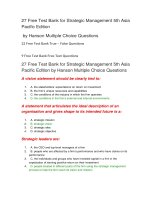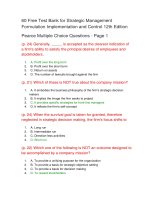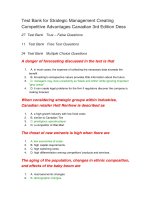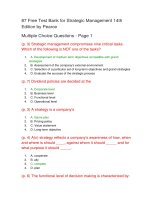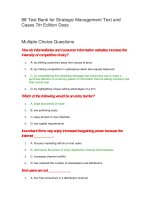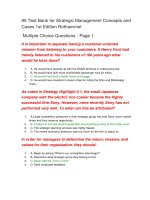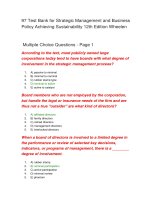Test bank for strategic management of technological innovation 4th edition schilling
Bạn đang xem bản rút gọn của tài liệu. Xem và tải ngay bản đầy đủ của tài liệu tại đây (78.87 KB, 13 trang )
Test Bank for Strategic Management of Technological
Innovation 4th Edition Schilling
Multiple Choice Questions
_____ are regional groups of firms that have a connection to a common
technology, and may engage in buyer, supplier, and complementor
relationships, as well as research collaboration.
1.
a. Technology transfer offices
2.
b. Regional incubators
3.
c. Strategic business units
4.
d. Technology clusters
_____ approach to research and development assumed that innovation
proceeded linearly from scientific discovery, to invention, to engineering,
then manufacturing activities, and finally marketing.
1.
a. Demand-pull
2.
b. Market-pull
3.
c. Supply-push
4.
d. Science-push
Erison Group, an advertising company, wants to hire an individual for the
post of creative head. Which of the following is the characteristic that the
company has to look for while recruiting for that particular post?
1.
a. An individual who completely adheres to the existing logic and paradigms and
has extensive knowledge of the field
2.
b. An individual who has low tolerance for ambiguity, and avoids taking risks
3.
c. An individual who has a moderate degree of knowledge of the field, but is
intrinsically motivated
4.
d. An individual who prefers to look at problems in conventional ways
Which of the following is true about the Bayh-Dole Act of 1980?
1.
2.
3.
4.
a. It made university technology transfer activities illegal and unethical.
b. It allowed universities to collect royalties on inventions funded with taxpayer
dollars.
c. It restricted provision of patents for inventions developed at universities.
d. It made investment in research and technology mandatory for public
companies.
Which of the following is an example of applied research?
1.
a. A study on Abraham Maslow’s hierarchy of needs theory
2.
b. A study on the acidic nature of phenols
3.
c. A study on the ways to increase employee retention in the software industry
4.
d. A study on the structure of neutrons, electrons, and protons
A variety of rice created by Biocrop Inc., through recombinant DNA
technology, was found to be rich in both carbohydrates and proteins.
After the success of this rice variety, the particular technology was
implemented by less-developed countries to increase the nutrient level of
fruits, pulses, and greens in order to feed their malnourished children.
This is an example of _____.
1.
a. technological cluster
2.
b. technological spillover
3.
c. technological convergence
4.
d. technological determinism
When companies form a technology cluster it often results in:
1.
a. the loss of agglomeration economies.
2.
b. new firms being discouraged to start up in the immediate vicinity.
3.
c. reduced interaction and trust between them.
4.
d. reduced pricing power in their relationships with buyers and suppliers.
Susan, a biologist, works in the research and development department of
a chemical company. The company has assigned her to study the
reproduction processes of various insects to develop an effective
technique to control insect damage to crops. The type of research Susan
is engaged in is called _____ research.
1.
a. basic
2.
b. applied
3.
c. exploratory
4.
d. quantitative
_____ is the ability of an organization to recognize, assimilate, and utilize
new knowledge.
1.
a. Cognitive ability
2.
b. Absorptive capacity
3.
c. Organizational agility
4.
d. Reasoning ability
Organizations that manufacture products such as light bulbs for lamps, or
DVDs for DVD players are examples of _____.
1.
a. moderators
2.
b. lead users
3.
c. complementors
4.
d. incubators
The benefits firms reap by locating in close geographical proximity to
each other are known collectively as _____ economies.
1.
a. agglomeration
2.
b. closed
3.
c. virtual
4.
d. shadow
Which of the following is the correct sequence of steps for the sciencepush approach to research and development?
1.
a. Customers express an unmet need, R&D develops the product to meet that
need, the product is manufactured, and finally the marketing team promotes the
product.
2.
b. Scientific discovery leads to an invention, the engineering team designs the
product, it is manufactured, and finally the marketing team promotes it.
3.
c. Marketing discovers a need, R&D comes up with the product concept which is
refined by engineering, the manufacturing team produces it, and finally the product
is sold.
4.
d. Manufacturing sees a way to improve a product, the engineering team
redesigns it, and finally the marketing team creates awareness about the improved
product.
The demand-pull approach to research and development refers to:
1.
a. research and development that focuses on developing products that are
expected to increase demand in a particular market segment.
2.
b. research and development that begins by examining the outcomes of the firm’s
basic research and the potential commercial applications that may be constructed
from those outcomes.
3.
c. research and development that focuses on developing products that are
expected to decrease the demand for their substitute products.
4.
d. research and development that originates as a response to the specific
problems or suggestions of customers.
Which of the following is an example of user innovation?
1.
a. Samuel has invented a detachable bicycle in order to make profits by selling it
to a reputed bicycle manufacturing firm.
2.
b. Sandra, an engineer, has developed a device that helps track the location of her
teenage daughter’s car.
3.
c. Jessica, an ace designer for a clothing brand, has been asked to work on a
dyeing technique that changes fabric color according to the room temperature.
4.
d. Ivan, a scientist at a reputed pharmaceutical company, has developed an antiinflammatory drug for the company to commercialize.
The term _____ indicates that the product is novel to the individual who
made it, but known to everyone else.
1.
a. discovery
2.
b. reinvention
3.
c. creativity
4.
d. innovation
The president of Mountain Home University has been asked by her board
of trustees to set up a separate unit to facilitate the commercialization of
technology developed by the research students at the university. Such a
unit is typically called a _____.
1.
a. strategic business unit
2.
b. commercialization office
3.
c. technology transfer office
4.
d. science park
In 2001, Shanghai’s Municipal Government set aside 13 square kilometers
of land near the Huangpu River for university laboratories and start-up
firms in microelectronics, digital technology, and life sciences. The
project aimed to foster research in microelectronics, the development of a
technologically-advanced labor pool, and the creation of new industries in
Shanghai. This project would be best termed as a(n) _____.
1.
a. complementor
2.
b. strategic unit
3.
c. science park
4.
d. free trade area
Which of the following is true of interfirm collaborative research and
development networks?
1.
a. Collaborative research networks are not important and viable in high-technology
sectors.
2.
b. Interfirm networks enable firms to achieve much more than they can achieve
individually.
3.
c. The flow of information and other resources through a network is independent of
the network’s size.
4.
d. Information diffusion is fairly slow and limited in collaborative research networks
with dense structures.
Institutions designed to nurture the development of new businesses that
might otherwise lack access to adequate funding or advices are called
_____.
1.
a. complementors
2.
b. research collaboration offices
3.
c. incubators
4.
d. technology clusters
Which of the following is characteristic of successful inventors?
1.
a. They specialize solely in a single field rather than several fields simultaneously.
2.
b. They are curious and more interested in solutions than problems.
3.
c. They blindly accept the assumptions made in previous work in the field.
4.
d. They seek global solutions rather than local solutions.
_____ are individuals or organizations that transfer information from one
domain to another in which it can be usefully applied.
1.
a. Knowledge brokers
2.
b. Knowledge workers
3.
c. Complementors
4.
d. Category captains
Regional districts that are set up by the government to foster R&D
collaboration between government, universities, and private firms are
typically called _____.
1.
a. technological trajectories
2.
b. free trade areas
3.
c. complementors
4.
d. science parks
_____ is a positive externality from R&D resulting from the spread of
knowledge across organizational or regional boundaries.
1.
a. Technological convergence
2.
b. Technological determinism
3.
c. Technological spillover
4.
d. Technological cluster
Which of the following is considered to be a novel idea?
1.
a. A detergent that is advertised as a very effective stain-remover
2.
b. A company announces that it has produced a recreational hovercraft for kids
3.
4.
c. An announcement by a cell phone company that it now offers free text
messaging
d. An announcement by a college that it will install artificial turf on its football field
Breaking Ventures Inc. realized that most parents are worried about their
teenage children going out on their own. Based on this information, the
company developed a device that could be fixed into the concerned
person’s cell phone, and this device helped parents keep track of their
children’s location. This approach to research and development is
referred to as _____.
1.
a. demand-pull
2.
b. supply-push
3.
c. science-push
4.
d. research-pull
True - False Questions
An organization’s overall creativity level is a simple aggregate of the
creativity of the individuals it employs.
1.
True
2.
False
The science-push approach to research and development argued that
innovation was driven by the perceived demand of potential users.
1.
True
2.
False
Incubators are regional districts, typically set up by government, to foster
R&D collaboration between government, universities, and private firms.
1.
True
2.
False
The degree to which innovative activities are geographically clustered is
independent of the national differences in the way technology
development is funded or protected.
1.
True
2.
False
If an individual knows a field too well, it can stifle creativity.
1.
True
2.
False
Tacit knowledge is knowledge that can be documented in written form.
1.
True
2.
False
Proximity and interaction can directly influence firms’ ability and
willingness to exchange knowledge.
1.
True
2.
False
The terms research and development represent different kinds of
investment in innovation-related activities.
1.
True
2.
False
The qualities that make people inventive also make them entrepreneurial.
1.
True
2.
False
Firms form alliances with competitors to jointly work on an innovation
project or to exchange information.
1.
True
2.
False
Innovation often originates with those who create solutions for their own
needs.
1.
True
2.
False
Knowledge that is explicit requires more frequent and close interaction to
be meaningfully exchanged than knowledge that is tacit.
1.
True
2.
False
Collaborative research is prohibited in high-technology sectors.
1.
True
2.
False
The decline in the government share of spending on R&D is largely due to
the rapid increase in industry R&D funding rather than a real decline in the
absolute amount spent.
1.
True
2.
False
Monetary rewards undermine creativity by encouraging employees to
focus on extrinsic rather than intrinsic motivation.
1.
True
2.
False
The intellectual property policies of a university embrace both patentable
and unpatentable innovations.
1.
True
2.
False
Knowledge that cannot be readily codified is called explicit knowledge.
1.
True
2.
False
Inventors tendency toward introversion cause them to be good at
manipulating concepts.
1.
True
2.
False
An individual with only a moderate degree of knowledge of a field will be
able to produce more creative solutions than an individual with extensive
knowledge of the field.
1.
True
2.
False
User innovators typically create new product innovations in order to profit
from the sale of the innovation to customers.
1.
True
2.
False
5 Free Test Bank for Strategic Management of
Technological Innovation 4th Edition Schilling Free
Text Questions
Explain the concept of technology spillovers.
Answer Given
Technological spillovers are a positive externality from R&D resulting from the
spread of knowledge across organizational or regional boundaries. Technology
spillovers are a significant influence on innovative activity. The likelihood of
spillovers is also a function of the nature of the underlying knowledge base and
the mobility of the labor pool.
You have just been given an assignment within your company to design a
creativity training program. Describe the elements you would include in
the program and explain the rationale of each one.
Answer Given
One element of a creativity training program would be to bring in a
communications expert to teach managers how to encourage novel thinking and
autonomy through the use of verbal and nonverbal cues. The program might also
include exercises that encourage employees to consider simpler representations
of a problem to avoid getting “bogged down” in the details, and develop
rudimentary prototypes. The program probably should not entail extrinsic (e.g.,
monetary) rewards, and instead should encourage intrinsic rewards such as
recognition, giving the employees considerable ownership over their projects, and
emphasizing the beneficial impact new solutions have on the welfare of
customers. The programs also often incorporate exercises that encourage
employees to use creative mechanisms such as developing alternative scenarios,
using analogies to compare the problem with another problem that shares similar
features or structure, and restating the problem in a new way.
At a retreat by the Salisbury City Council, community leaders held a
discussion on attracting and developing new businesses and increasing
employment rates in the city. One leader suggested that the city should
consider sponsoring a business incubator. Explain what an incubator is
and how this might help the city meet its goals.
Answer Given
An incubator is an institution designed to nurture the development of new
businesses that might otherwise lack access to funding or advice. It allows
companies to share costs and resources until they can stand on their own. If an
incubator were started in Salisbury, it would help new businesses to grow and
prosper. These businesses could then move out to locations of their own and hire
local residents as employees. The city would not have to offer tax breaks or
compete with other cities for the location of existing companies, but would be
growing their own businesses.
If you are looking for a location for your software development company
why will you consider Silicon Valley? What are the drawbacks to this
location?
Answer Given
A software development company would find a technology cluster such as Silicon
Valley attractive because many other high-tech computer-oriented companies are
located there. The software company might be able to share information with
complementors or find new employees who have been trained by other
companies. Drawbacks to that location might include the fact that other companies
hire away their employees or other companies might find out about proprietary
technologies the company is developing. Current employees may follow the
examples of others and leave the software development company to start their
own company.
If you were in charge of a research and development (R&D) department for
a large pharmaceutical company, would you encourage the employees to
perform basic research or applied research? Provide the rationale for your
answer.
Answer Given
The research and development (R&D) department for a large pharmaceutical
company should probably encourage its researchers to do both basic research
and applied research. Basic research is directed at increasing understanding of a
topic or field. This type of knowledge will help the company to better understand
the medical field and to come up with approaches to applied research. For
example, research to understand why and how people develop diabetes would
provide useful information for the treatment. Applied research is targeted at
increasing knowledge for a specific application and is aimed at fulfilling
commercial objectives. The development of new methods of treatment based on
the findings of basic research would be the next logical step to take. This type of
research would also require creativity and innovation but would be targeted at
treating an illness in a certain way.

